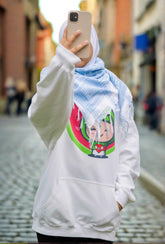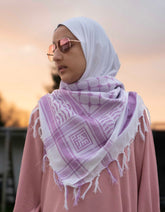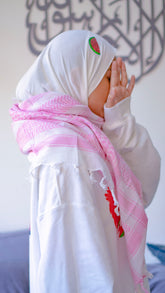If you have other questions, please send them to team@bubblegirl.co.
Parents' FAQ's
Age Consideration:
Introducing the concept of hijab can begin at a young age, even as early as 5 or 6, but in a very gentle, age-appropriate manner. Young children are naturally curious and may already have questions if they see family members or friends wearing it. The key is to approach the topic as a natural part of your Islamic teachings and household conversations.
Guidelines for the Conversation:
- Start Simple: Begin with the basics. Explain that the hijab is a special scarf that many Muslim women and girls choose to wear as a part of their faith. Use simple terms and relatable analogies. For instance, "Just as we wear special clothes for special occasions, some women wear hijab as a special act of love for Allah."
- Share Personal Stories: If you wear a hijab or have close family members who do, share personal experiences. This can make the concept more relatable and less abstract.
- Introduce Gradually: Instead of a formal conversation, introduce the idea over time. For instance, while reading bedtime stories, include books that feature characters wearing hijabs or when watching TV shows or videos, point out and discuss hijabi characters.
- Highlight Choice & Empowerment: Emphasize that wearing the hijab is a personal decision and a special commitment to Allah. Make sure she understands that it's a choice she can make when she feels ready and that it's a symbol of faith, pride, and identity, not just a piece of cloth.
- Address Modesty Beyond the Headscarf: While discussing hijab, it's a good opportunity to introduce the broader concept of modesty in Islam, which includes behaviour, speech, and dress. Let her know that hijab is not just about covering one's hair but also about a modest and dignified way of presenting oneself.
- Encourage Questions: Allow her to voice any thoughts, questions, or concerns. Be open to her queries, and if you don't know the answer, take it as an opportunity to learn together.
- Revisit the Conversation: As she grows and matures, her understanding and perspective on hijab will evolve. Ensure that the conversation about hijab is ongoing, adapting to her age, experiences, and changing environment.
Remember, the goal is not to impose the hijab but to instil a love and understanding for it. It's about nurturing an environment where she feels empowered to make an informed decision when she believes the time is right.
The concept of hijab and modesty is mentioned in several places within the Quran. The primary verses that directly address the issue of covering and modesty for women are found in Surah An-Nur (24:31) and Surah Al-Ahzab (33:59).
- Surah An-Nur (24:31):
"And tell the believing women to reduce [some] of their vision and guard their private parts and not expose their adornment except that which [necessarily] appears thereof and to wrap [a portion of] their headcovers over their chests and not expose their adornment except to their husbands, their fathers, their husbands' fathers, their sons, their husbands' sons, their brothers, their brothers' sons, their sisters' sons, their women, that which their right hands possess, or those male attendants having no physical desire, or children who are not yet aware of the private aspects of women. And let them not stamp their feet to make known what they conceal of their adornment. And turn to Allah in repentance, all of you, O believers, that you might succeed."
This verse specifically talks about the concept of guarding one's modesty and mentions the idea of women covering their adornments.
- Surah Al-Ahzab (33:59):
"O Prophet, tell your wives and your daughters and the women of the believers to bring down over themselves [part] of their outer garments. That is more suitable that they will be known and not be abused. And ever is Allah Forgiving and Merciful."
This verse instructs the Prophet Muhammad to advise the Muslim women to cover themselves for their protection.
It's important to understand these verses within their historical and socio-cultural context. The guidance is rooted in promoting modesty, dignity, and protection for women. When discussing these verses, it's also beneficial to consult with scholars or detailed tafsir (exegesis) to gain deeper insights into their meanings and implications.
The decision to wear a hijab is deeply personal. Encourage open conversations with your child about her feelings and reasons. Share resources, stories, or introduce her to other hijabi women who can provide insights from their experiences. Ultimately, support her in making an informed decision that aligns with her faith and identity.
It's natural to have concerns. Equip your child with knowledge and confidence. Discuss potential scenarios she might encounter and ways to address them. Engage with her school to ensure a supportive environment. Most importantly, instill in her the pride and significance of her choice, so she remains resilient in the face of challenges..
Encourage open dialogue. Equip your child with simple and clear answers that explain the significance of the hijab. It's also essential to foster an environment where she feels proud of her choice. Engaging with her school and teachers can help in creating a more informed and inclusive setting.
The hijab is versatile and can beautifully integrate cultural elements. Whether it's using traditional fabrics, patterns, or accessories, encourage your daughter to explore and celebrate her multicultural identity through her hijab. It can be a wonderful way for her to connect with her roots.
Your child's hijab journey is not just theirs but yours as well. Your support, understanding, and encouragement play a pivotal role. Embrace this journey with love, patience, and pride. Together, as a family, you're crafting a beautiful story of faith, resilience, and empowerment.
When your daughter is grappling with her self-image after choosing to wear the hijab, it's essential to approach the situation with sensitivity and support:
-
Reinforce Positive Values: Begin by reminding her of the reasons she chose to wear the hijab, emphasizing its significance in Islam and the strength and commitment she's demonstrating. Help her understand that her self-worth isn't solely tied to external appearances, but her character, beliefs, and actions.
-
Share Stories of Inspiring Hijabi Women: Highlight women, both from Islamic history and modern times, who have achieved remarkable feats while wearing the hijab. From pioneers like Khadija (RA), the first woman to embrace Islam, to contemporary figures like Olympic athletes and renowned scholars. Their stories can serve as powerful reminders that the hijab is a source of empowerment, not limitation.
-
Ensure She Has a Supportive Community: Engage with a community or group where she can interact with peers and mentors who wear the hijab. This can be a space for her to share her feelings, listen to others' experiences, and feel less isolated. Encourage her to participate in "Bubble Girl" activities and events, where she can connect with others on similar journeys.
-
Celebrate Her Individuality: Encourage her to express herself and her style within the bounds of modesty. Whether it's through the colors and styles of her hijabs or her other talents and hobbies, let her know that wearing a hijab doesn't diminish her uniqueness.
-
Open Dialogue: Make sure she knows she can always come to you with her concerns. Sometimes, just being heard can be a huge relief. Provide her with resources, books, or seminars that address self-esteem and self-worth from an Islamic perspective.
Remember, self-image struggles are common during adolescence, and the addition of hijab can add another layer to that. Your continued support and understanding are crucial during this phase.
Absolutely! There are many books and articles that delve into the cultural, spiritual, and social aspects of wearing a hijab. "The Beauty of Modesty","Hands of My Hijab" and "Hijab in Islam: Modesty, Humility, and Dignity" are a few recommended reads. Additionally, attending local seminars or workshops can provide valuable insights.
A: It's a common challenge for many starting their hijab journey. Consider seeking advice from older hijabis or watching our online tutorials tailored for young girls. Investing in comfortable and adjustable hijabs, especially ones designed for younger wearers, can also make a significant difference. Our SoftTouch Hijabs are made smaller for young girls and can be styled in many different ways, have a look our Hijab Style page for inspiration. Our FeatherLite Hijabs are very simple for young girls and again can be styled in many different ways.





